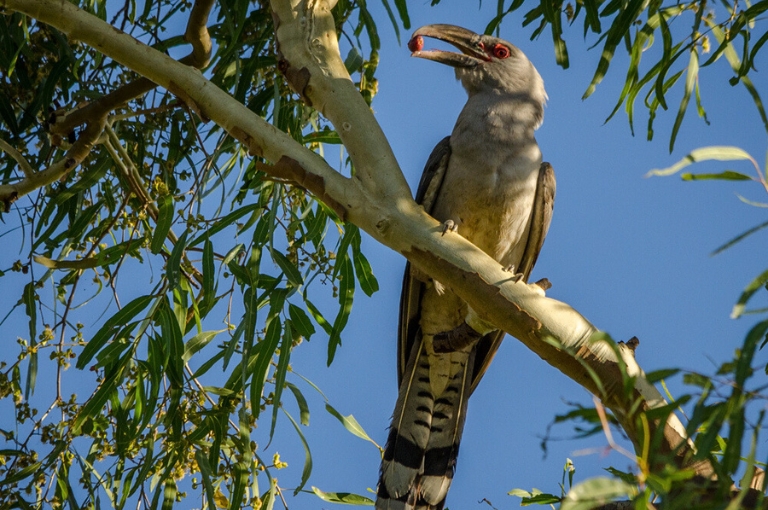
For many Australians, the loud rasping call of the channel-billed cuckoo that echoes those of their dinosaur ancestors, heralds the start of Spring. Known traditionally by First Australians as the stormbird, floodbird or rainbird, due to their propensity for arriving like clockwork with the onset of the rainy season, these large birds are a regular seasonal migrant native to the Australo-Papuan region (Australia, Papua New Guinea and Indonesia).
Other than their raucous call, channel-billed cuckoos, whose wingspans measure up to one metre, are easily identifiable by their characteristic bright red eye and socket and impressive toucan-like grey bill.
Arriving in northern Australia from Papua New Guinea with the onset of the wet season in September, the birds move steadily south across a broad front as far as East Gippsland. On rare occasion, vagrant channel-bills show up in New Zealand, after being blown helplessly off course by high winds.
The channel-bill’s annual arrival is timed to coincide with the nesting season of larger resident bird species such as currawongs, magpies and wattlebirds whose nests they lay their eggs in. Unlike most other cuckoo species, however, channel-bills rarely eject the young of the host bird, and on occasion, more than one cuckoo can be observed being raised together in the same nest as their unrelated siblings.
Hatchlings take around three weeks to mature from eggs to independence, with departure from the nest occurring over three to four days, with increasingly adventurous forays from the nest. The departure of adults and juveniles from summer breeding areas generally occurs during March and April, with the final stragglers leaving our northern shores from June to July.
The bird’s diet is mainly comprised of fruit, such as those from native figs and mulberries, but they also feed on insects and the occasional hatchlings of smaller bird species.
The channel-billed cuckoo is one of only a few migratory birds that is experiencing an upturn in numbers in some areas. However, this has been attributed by some researchers to the increasing abundance of Australian magpie and pied currawong, in particular across southern Queensland and eastern NSW. Unlike most other native bird species, these habitat generalists (species that can live in many different types of environments and have a varied diet) have been able to adapt well to the replacement of their natural woodland habitat with manicured grass lawns. This boost in magpie and currawong numbers is in turn putting increasing pressure on small bird species, such as fairywrens and thornbills, upon which channel-bills prey.
Much remains to be learned about Australia’s charismatic stormbirds – we still know little about exactly where channel-bills travel after leaving their southern breeding grounds enroute back to Papua New Guinea and Indonesia. Nor do we fully understand the relationship between weather, air currents and how the bird makes its incredible long-distance journeys. Of particular concern is the lack of knowledge about what is happening with their habitats across the oceans, many of which remain under growing pressure from timber harvesting and the clearing of forests to make way for farmland.
To help ensure the future of our channel-billed cuckoos, GER is working to establish a new project to explore how our cuckoo species are faring, what risks they face and what actions need to be taken to ensure that our modern-day pterodactyl continues to thrive.



 Blog
Blog